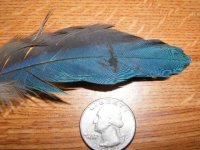- Thread Starter
- Thread starter
- #21
Rosey, thanks for the correction. It seems I put a link to the high potency formula - it makes sense that that would have the seeds and fatty ingredients. I hadn't realized, I just looked up ingredients for it.
That's ok AD. I had been looking at the ingredients as well. Trying to figure out what to give him and why. I read the back of the bag when it got here and thought...you are kidding right? I am trying to get him to not eat seeds and here is a pellet made with...what?...SEEDS. So that's where my research began. I think he has been eating it some. His poop was brown almost all day yesterday. Today its back to green...the only thing is that his favorite Pretty Bird pellet seems to be the green ones....so not entirely sure why its green. He also eats a lot of greens. I have to look into that as well while I am on here tonight.
RHonda
